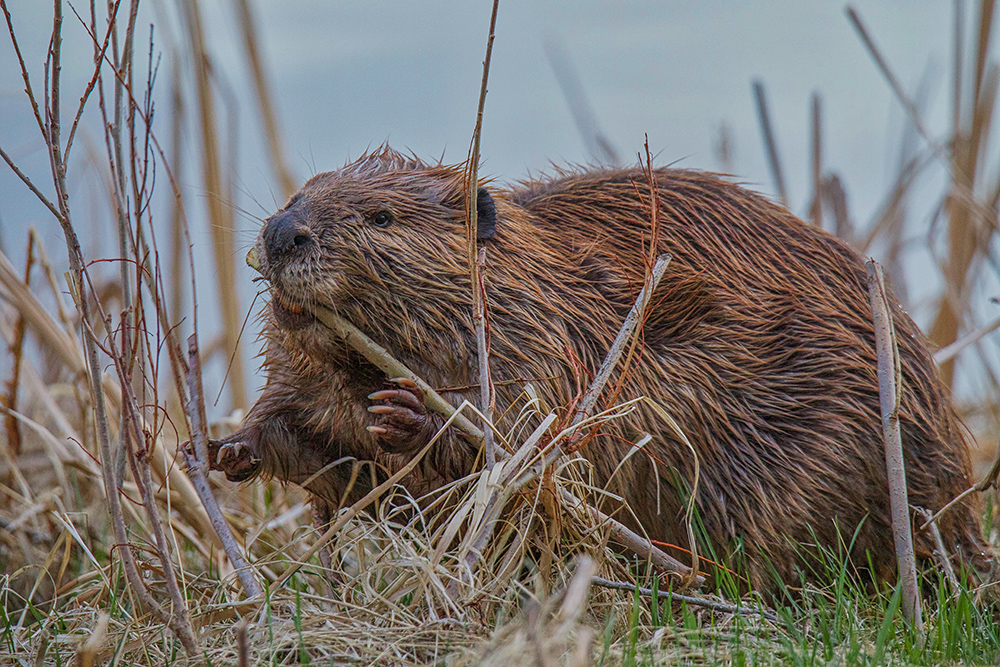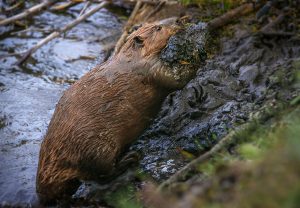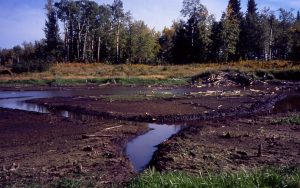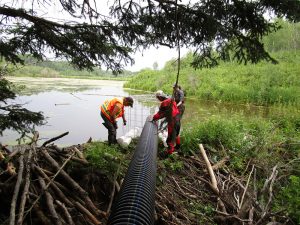Where Beavers Go, Surprises Follow

BY GLYNNIS HOOD
It’s an usually warm day in January and my snowshoes are only partially necessary on the frozen ponds that aid my route through the Ministik Game Bird Sanctuary in east-central Alberta. Having studied beaver populations and their influence on wetland ecosystems for 20 years in the Beaver Hills moraine, this is my first serious exploration of the beaver ponds of Ministik. It is a world that defies explanation at times — towering lodges, beaver dams dropping in step-like formation to yet another perched wetland, and then to another, and another. As I rest against a beaver lodge to have my tea, I realize that after all these years, there is still so much more to learn about these rodents, which can engineer entire landscapes unlike any other mammal, other than humans.
Various researchers have found that beavers prefer to live in ponds with gentle slopes. However, in a recent study in Miquelon Lake Provincial Park, immediately south of Ministik, I determined that just the opposite happens in the Beaver Hills; the steeper the slope, the more likely beavers will occupy the pond. There are some beaver ponds in Ministik and Miquelon with slopes well exceeding 70%, complete with multigenerational foraging trails leading straight up the steepest banks. This winter, when my field assistant and I came across the top of a beaver foraging trail, we could see nothing but air below the ends of our snowshoes. The descent to the pond had a slope of about 75%; our enthusiasm tempered by a good dose of common sense, we chose another route down. This preference for steeper slopes in a landscape dominated by isolated ponds allows beavers closer access to preferred food sources, such as trembling aspen.
Beaver History: Collapse and Recovery
North American beaver populations, along with their Eurasian cousins, have made a remarkable comeback after collapsing from fur-trade overharvest. A great deal of this success is attributed to strict conservation policies and early reintroduction efforts, but the tenacity and adaptability of these large rodents have been central to their successful recovery. Their versatility makes beavers one of the most widespread mammals in North America, ranging from the Arctic Ocean to northern Mexico. With a warming climate, beavers are now moving from northern river systems and deltas directly onto the Arctic tundra as it becomes increasingly colonized by shrubs.

Beaver - R. Price
The history of beavers in the Beaver Hills has included both overexploitation and conservation. This area, known as Amiskwaciy (“beaver hills”) in Cree, was an important hunting and resting area for many Indigenous peoples. The early fur trade brought heavy commercial trapping, and subsequent European settlement resulted in extensive deforestation through fire and logging. Beavers were completely trapped out in the Beaver Hills by the mid to late 1800s. Fortunately, this period of decline was followed by dedicated efforts to restore and conserve beavers and several other species that suffered a similar fate.
In 1899, the Federal Department of Interior established the Cooking Lake Forest Reserve, part of which is now the Cooking Lake-Blackfoot Provincial Recreation Area. Additional protected areas soon followed: Elk Island National Park in 1906, Ministik Game Bird Sanctuary in 1911, and Miquelon Lake Bird Sanctuary in 1920 (later Miquelon Lake Provincial Park in 1958). After the successful reintroduction of beavers from Banff National Park into Elk Island National Park in 1941, likely augmented with natural recolonization, the Beaver Hills again began to live up to their name. Beavers have now made their home throughout the moraine.
Beavers as Ecosystem Engineers
Because of the early conservation interest in the moraine, we have a well-established aerial photo record that dates back as far as the 1920s. Comprehensive aerial photo sets started in the 1940s. My analysis of these photos over a 54-year period (1948 to 2002) in Elk Island National Park showed that, even during the record-breaking drought of 2002, ponds with beavers had nine times more open water than those same ponds when beavers were absent. The presence of beavers explained over 80% of the annual variability in the extent of open water in the park. The results were so shocking that I reanalyzed the data and reviewed the aerial photographs several times before my PhD supervisor, Suzanne Bayley, and I sent the article for peer review.
My next question was why. Unlike what I have seen in Ministik, many of my study ponds in Elk Island lacked dams, and dams that did exist were usually associated with roadside culverts, or were relatively small. Permanent streams are uncommon, and there are no rivers in the 194-km2 park.

Drought Pond
The answer began to reveal itself as I sat next to an occupied beaver pond during the drought of 2002. A series of open mudflats lay before me. But unlike the dry, flat-bottomed ponds elsewhere in the park, the bottoms of these occupied ponds had deep, water-filled channels, excavated by beavers in a complex branching pattern (see photo). They originated from the main entrance of the lodge and then radiated throughout the pond to key upland foraging areas. It seemed to me then that there was more to these channels than just access routes to favourite food sources.
A few years later, in Miquelon Lake Provincial Park, I decided to quantify the often-cited description of beavers as ecosystem engineers. Although dams and lodges are the most recognized structures that beavers build, beaver channels along the bottom of the pond and extending perpendicular from the water’s edge can be extensive. The longest channel I have measured is just under 500 m, likely excavated over several years. Most channels are much shorter, with many just under a metre deep and a metre wide. More than once, water lapping at the tops of our chest waders indicated that some channels are well over a metre deep. More fascinating than the length and depth of these channels is the impact they have on the configuration of riparian habitats and the increased volume of water in these ponds.
Through my studies, I determined that the creation of beaver channels increases the perimeter of a pond by an average of 575%. This is critical because riparian edges — those margins along water bodies where land and water meet — support high levels of biodiversity. Average surface area of these ponds also increased because of these channels. Most importantly, the volume of ponds with beavers was approximately 25% greater than ponds that were abandoned by beavers. Much of this increase in pond volume was directly related to increased depths of the ponds as beavers excavated and reconfigured the pond bottoms. Beaver channels appear to focus water from upland areas directly into the ponds.
The amount of effort required to create these channels is staggering. I calculated that in the excavation of channels, beavers moved over 1,700 m3 of soil for every square kilometre of park. A typical dump truck moves approximately 10 m3 of soil in one load. Now imagine beavers excavating the equivalent of over 17 dump trucks worth of soil for every square kilometre of park! These numbers reveal what ecosystem engineers can do, over and above the construction of dams and the flooding of adjacent areas. These channels are enduring, often lasting more than a decade after beavers are gone. Ponds with channels are the last to dry up in a drought, and the first to refill once it is over.
By modifying the shorelines and basins of ponds so dramatically, habitat complexity increases, which in turn influences habitat use and availability for other species. In a study with Dr. David Larson, we collected samples of aquatic invertebrates at three different habitats within occupied and unoccupied beaver ponds: along the vegetated shoreline, in the open water column, and in beaver channels. We fully expected that beaver channels would function much like the vegetated edges of the ponds, but were surprised to find that beaver channels served as “hunting hotspots” for predaceous aquatic invertebrates. Perhaps the regular movement of water in and out of the channel when beavers used them to access foraging areas, or the release of other food sources as beavers excavated the sides and bottoms of the channels, provided a regular influx of new prey. Whatever the reason, these tiny aquatic predators were found in higher abundance in these often-overlooked habitats. Other invertebrate species were also found exclusively in active beaver ponds, regardless of the type of habitat they used within the pond.
While sampling for invertebrates, we started to notice that other species appeared to be attracted to beaver channels as well. In a joint study with Nils Anderson and Cindy Paszkowski, we investigated the use of beaver ponds by wood frogs. These frogs mate in water, are born in water, and then disperse to upland areas as young frogs until they return to the ponds to mate as adults. We found that young and adult dispersing wood frogs were nine times more abundant in beaver channels than in regular shoreline habitats. We believe these channels serve as movement corridors for the dispersing frogs, providing additional protection from predation and injury as they move to upland habitats.
With all of these channels “reaching out” to the surrounding landscape, beaver channels can also help decrease the distance from one wetland to another quite dramatically. This is critical in the Beaver Hills, which is a landscape dominated by geographically isolated wetlands. Any connection between these water bodies provides ecological opportunities for species’ movements across the landscape. Currently, my research team and I are using specially placed wildlife cameras, environmental DNA, and wildlife signs (e.g., beaver lodges, wildlife tracks, muskrat huts and push-ups) to assess how land use, aquatic connectivity, and species associations influence the distribution of a suite of semi-aquatic mammals across the Beaver Hills.
From the tiny American water shrew and northern bog lemming, to muskrat, beaver, and mink, to the possible presence of river otter, it takes a suite of clues to understand how ecosystem engineering and species interactions might influence entire ecological communities. Beavers are just part of the picture, but their temendous influence on freshwater systems could play an important role in the presence of these other species, some of which have declining populations in Alberta.
Managing Beaver Conflicts
Despite their important ecological role, beavers continue to be a controversial species. People phone and email me regularly to ask where they can obtain beavers for their properties, or to ask how to get rid of them and reduce the damage associated with flooding and felled trees. There is a definite financial cost to living with beavers. To quantify this cost, Varghese Manaloor, Brendan Dzioba, and I surveyed 48 municipalities (including rural counties) and four provincial parks in Alberta. We estimated that beaver management (prevention, dam removals, and repairs) costs Alberta municipalities over $3 million per year. Given incomplete cost accounting by several municipalities, we considered these costs to be very conservative.

Pond Leveller Install G. Hood
Fortunately, management alternatives, such as pond levellers, exist to help reduce these costs. Pond levellers are made from a series of large plastic pipes and a protective cage that, once placed through a dam, maintain the pond at a constant level (see photo). Thus, the pond can remain (rather than being drained), nearby facilities are protected from flooding, and the ecological benefits of beaver ponds remain. Over the years, we have installed around 30 of these devices with a good deal of success. When we conducted a cost-benefit analysis of the levellers we had installed in the Cooking Lake-Blackfoot Provincial Recreation Area, there was a net benefit of over $81,000 relative to traditional management approaches. Now organizations including Cows and Fish and the Miistakis Institute have taken the lead. Increasingly, pond levellers are seen as a cost-effective way to help humans and beavers coexist.
In many ways, beavers helped open up North America to European exploration and colonization. It was an era that almost resulted in the species’ demise. Its return brings with it water, biodiversity, connectivity, and a bit of conflict requiring imaginative solutions for coexistence.
As my snowshoed feet pass by yet another beaver lodge, I cannot help but imagine what is yet to be discovered about this animal that transforms ecosystems in such dramatic ways, and enhances our understanding of how the loss of one species could affect the ecological health of so many others.
Dr. Glynnis Hood is an ecologist and Professor of Environmental Science at the University of Alberta’s Augustana Campus in Camrose. Her research interests include aquatic ecology, wildlife management, and human-wildlife interactions. She is the author of Semi-Aquatic Mammals: Ecology and Biology and The Beaver Manifesto.
This article originally ran in Nature Alberta Magazine - Spring 2021.
